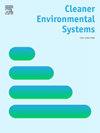原始设备制造商的产品即服务转型:挑战,性能指标和设计指南-电气和电子设备的情况
IF 4.9
Q2 ENGINEERING, ENVIRONMENTAL
引用次数: 0
摘要
产品即服务(PaaS)是一种循环商业模式,它允许原始设备制造商(oem)增强其产品供应,并通过诸如维修、再利用、翻新、再制造和随后的回收等层叠价值保留过程获取经济价值。从传统的产品所有权模型到PaaS模型的转变需要在如何设计、交付和支持产品方面进行系统的转换。在本文中,我们关注的是面向消费者市场的电子电气设备(EEE)的PaaS模型。为了确保成功部署,我们确定了PaaS转型的四个关键支柱:产品设计、服务提供、启用技术和支持基础设施。通过这项研究,我们探索了如何将已确定的挑战与指标和指导方针联系起来,作为四大支柱的潜在解决方案。通过应用PRISMA和文献计量分析,我们确定了229个挑战、182个指标和169个设计障碍,并将它们归类为PaaS的四个基本支柱:产品、服务、技术和基础设施。我们的研究结果突出了与基础设施和技术相关的性能指标和设计指南的显着缺陷,导致缺乏支持循环PaaS产品和生态系统开发的方法和工具。本研究建议将挑战、性能指标和设计指南相互联系起来,最终为设计师和决策者提供PaaS决策指导。本文章由计算机程序翻译,如有差异,请以英文原文为准。
Product-as-a-service transition for original equipment manufacturers: Challenges, performance metrics, and design guidelines – The case of electrical and electronic equipment
Product-as-a-Service (PaaS) is a circular business model that allows original equipment manufacturers (OEMs) to enhance their product offerings, and capture the economic value by cascading value retention processes like repair, reuse, refurbishment, remanufacturing, and afterward recycling. The shift from traditional product ownership models to PaaS models requires a systemic transformation in how products are designed, delivered, and supported. In this paper we focus on the PaaS models for electrical and electronic equipment (EEE) for consumer markets. To ensure successful deployment we identify four key pillars of PaaS transformation: product design, service offerings, enabling technologies and supporting infrastructure. Through this research, we explore how identified challenges can be linked to indicators and guidelines as potential solutions for each of the four pillars. By applying PRISMA and bibliometric analysis, we identified 229 challenges, 182 indicators, and 169 design barriers and categorize them within the four fundamental pillars of PaaS: products, services, technologies, and infrastructure. Our findings highlight a notable deficiency in performance indicators and design guidelines related to both infrastructure and technology, resulting in a lack of methods and tools to support the development of circular PaaS offerings and ecosystems. This study suggests relating challenges, performance indicators, and design guidelines with each other for ultimately coming up with PaaS decision guidance for both designers and decision makers.
求助全文
通过发布文献求助,成功后即可免费获取论文全文。
去求助
来源期刊

Cleaner Environmental Systems
Environmental Science-Environmental Science (miscellaneous)
CiteScore
7.80
自引率
0.00%
发文量
32
审稿时长
52 days
 求助内容:
求助内容: 应助结果提醒方式:
应助结果提醒方式:


